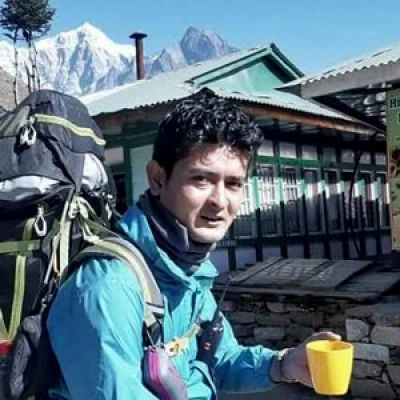Experiencing an Everest Base Camp (EBC) Helicopter Tour is like entering a domain where the magnificence of the Earth opens before your very eyes like a fairy tale. Imagine soaring above the world's highest peaks, where nature's grandeur dwarfs human existence and the excitement of adventure pulses through every heartbeat. The EBC Helicopter Tour promises an ethereal experience, revealing Mount Everest and the Himalayas from a unique perspective.
Challenges on EBC Helicopter Tour
However, within this ethereal attraction is a series of difficulties that will put both adventurers and pilots to the test. Nature's whimsy casts its spell, creating an ever-changing canvas of meteorological circumstances that necessitate rapid thinking and smart decisions. While the majestic altitude of the Himalayas is enchanting, it also offers a powerful foe in the form of altitude sickness, reminding tourists of their human limitations. The luxury of a helicopter trip, while tempting, comes at the expense of limited time to immerse oneself in the magical milieu and experience the welcoming spirit of local cultures.
This blog takes us on an exciting trip through the challenges and triumphs of an EBC Helicopter Tour. We'll solve the mystery of uncertainty in the weather, the fascination of mastering altitude's challenges, and the delicate equilibrium between luxury and true exploration. Join us as we traverse through the ups and downs of an EBC Helicopter Tour, revealing the essence of a moment that sparks the soul and creates an indelible impact on the human spirit.
Climate Conditions
Dealing with the unpredictable and harsh weather conditions in the Himalayas is one of the major obstacles of an EBC Helicopter Tour. The weather in the region can change quickly, resulting in dense clouds, fierce winds, and unexpected snowstorms. These hazardous weather conditions might endanger the flight's safety and require pilots to make hasty decisions to land or return to a safer area. Weather changes may also cause tour cancellations, causing disappointment among eager guests.
Altitude Sickness
The high altitude of the Everest region is renowned for inducing altitude sickness, often known as Acute Mountain Sickness (AMS). At higher heights, a shortage of oxygen can cause headaches, nausea, dizziness, and weariness. Even though a helicopter trip provides a faster rise and descent, passengers may have minor AMS. Pilots and tour operators must be aware of their passengers' medical status and have medical assistance on hand in case of an emergency.
Exploration Time is Limited
Although an EBC Helicopter Tour provides a stunning view of the Everest region, there is a trade-off: restricted time on the ground. Unlike climbing to Everest Base Camp, where visitors have days to acclimate and immerse themselves in the natural splendor, a helicopter tour offers only a limited amount of time for sightseeing. This time constraint can be difficult for those who want to see local culture, interact with Sherpa villages, or go on trekking excursions.
Environmental Implications
Concerns have been made regarding the environmental impact of helicopter excursions in the Everest region. Helicopter noise and air pollution can disrupt the sensitive Himalayan ecology, hurting species and the entire ecological balance. To reduce their environmental imprint, tour operators must be responsible for implementing eco-friendly methods and complying with conservation organization requirements.
High Prices
An EBC Helicopter Tour is unquestionably a lavish experience, and luxury comes at a high price. Helicopter trips can be substantially more expensive than other kinds of exploration, such as trekking. As a result, it is only available to those with a larger budget, limiting the experience to a restricted set of adventurers.
Technical Difficulties
Flying helicopters in the Himalayas' difficult terrain and thin air necessitates top-tier technical skills from pilots and ground crew. The region's harsh weather, unpredictable winds, and difficult landing places necessitate outstanding flying skills and a solid knowledge of the terrain. Maintenance and logistics issues often arise, as spare parts and support services are scarce in the remote Himalayan location.
As the helicopter's propellers slow and it gently touches down, we painfully wave farewell to the Everest Base Camp Helicopter Tour, a voyage that transcended mere sightseeing and morphed into an adventure of a lifetime. The difficulties we experienced were not simply hurdles, but threads that wove together a tapestry of amazing events that will live on in the heart of our being.
The EBC Helicopter Tour reminded us that the most amazing rewards in life are frequently found off the usual road. We embrace the peace of nature's raw beauty amidst the volatility of uncertain weather. We discover the strength within to rise above constraints and test our boundaries in the thin air of the Himalayas.
The delicate relationship between luxury and adventure taught us that joy does not exist in our comfort zones, but rather thrives when we immerse ourselves in the vivid tapestry of local cultures, leaving imprints of reverence and comprehension in our wake. Though the difficulties were evident, they served as catalysts for us to deepen our connection with the mountains, skies, and communities that call this magnificent region home. Nature humbled us as we traveled through the regions of excitement, telling us that we were simply passing through its everlasting sanctuary.
The Everest Base Camp Helicopter Tour gave us not just amazing views, but also the gift of self-examination gratitude, and a deep respect for the world's natural marvels. So let the memories of this incredible experience fire our spirits for future adventures when problems become stepping stones and life's splendor emerges in the face of hardship.




